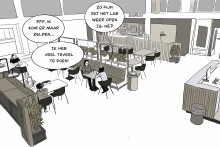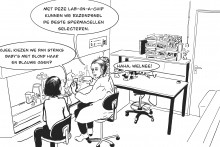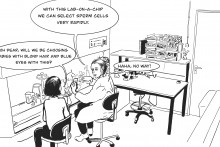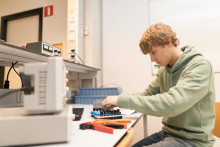As a part of his PhD research at the BIOS Lab-on-a-Chip group, Floris van den Brink aimed to investigate a method that would allow drug screening in the beginning phases of drug development. ‘One way to do that is to mimic the behavior of a liver directly on a chip,’ Van den Brink begins to explain how exactly this very small and very fast chip works.

‘We can reduce costs, as well as animal testing’
When foreign substances, for example medication or pollutants, enter our body, they can do harm within milliseconds. Such fast reactions are naturally difficult to examine, but the new chip is able to do that. ‘Our liver converts foreign substances into metabolites. These metabolites are potentially toxic, but also very short-lived, so they might never be detected,’ describes Van den Brink. ‘The chip also generates these unstable metabolites – just like our body - and it then tests how they react with endogenous biomolecules, for example hemoglobin. This way, the chip detects intermediate products that live only a few milliseconds, but could do damage to the human body.’
This method of testing pharmaceuticals is much faster than conventional procedures and it allows dozens of new medications to be tested on a daily basis. ‘The chip works in conjunction with common analytical methods such as mass spectrometry and gives results in a matter of minutes. If the results are negative, the tested substances should be abandoned,’ says Floris van den Brink. ‘If you can screen more thoroughly in the early stage, you can eliminate certain compounds instantly and therefore reduce costs, as well as animal testing.’
Predictive method to avoid potential damage
Could this method also be used for testing effect of poisons that have already entered the body? ‘The chip could detect reactions caused by poison, but this is a predictive method to avoid damage, rather than to detect damage that has already been done. The novelty of this chip doesn’t lie in the detection technique, but in the reactor that generates and examines metabolites,’ answers Van den Brink.
The development of the fast chip has been finished rather recently, and so the device is not yet used in practice. ‘It is not on the market yet, but we have collaborators in the industry who find this technique very interesting and we intend to continue the project,’ clarifies Van den Brink.
More information: Floris T. G. van den Brink et al. Oxidation and adduct formation of xenobiotics in a microfluidic electrochemical cell with boron doped diamond electrodes and an integrated passive gradient rotation mixer, Lab Chip (2016). DOI: 10.1039/C6LC00708B










